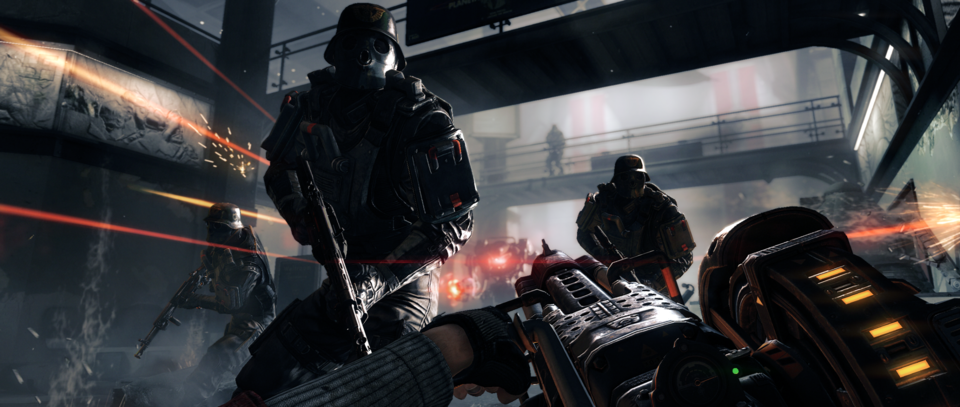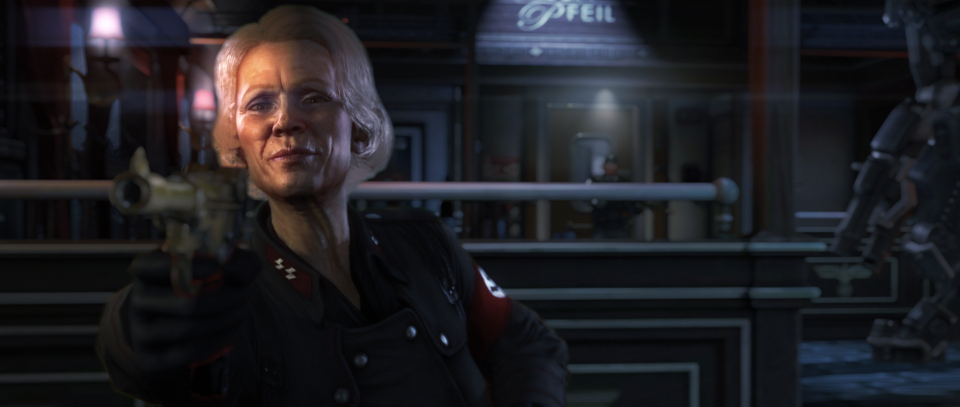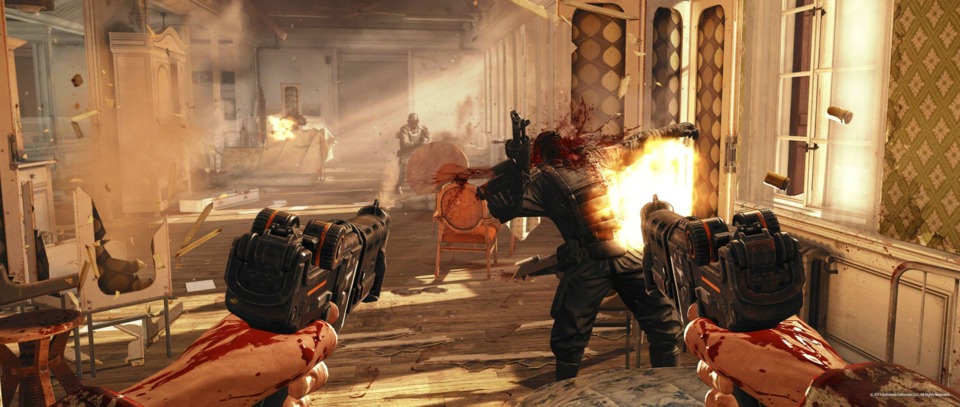Wolfenstein: The New Order is a lot of things. First and foremost, it is yet another update of id Software's enduring Wolfenstein franchise, a series mostly defined by its core concept of you shooting Nazis in the face. That's certainly one piece of The New Order, but developer MachineGames builds upon that core idea in several different ways. All the copious blood splatter and limb-exploding tech is joined by greater focuses on characterization, on pulpy sci-fi stylization, and, most importantly, on memorable storytelling. Which isn't to suggest that The New Order is successful in all of these areas. The New Order never quite settles on a consistent tone, nor does it often seem willing to afford its much-better-than-average characters enough time to really establish themselves to the player. It's a game that often feels like it's in a gigantic hurry to get the player to the next bout of Nazi killing, often at the expense of the character and world building the developers were clearly striving for. Yet The New Order mostly succeeds by virtue of how good the moments of character and world building you do get are, and by how rock solid the gameplay tends to be.

The New Order once again puts you in the blood-soaked boots of William "BJ" Blazkowicz, the lump of gun-holding meat that has starred in pretty much every version of Wolfenstein ever made. At the start, Blazkowicz finds himself in the middle of a D-Day-flavored raid on a massive Nazi compound...in 1946. In this game's timeline, World War II is still raging, and the Nazis have suddenly started surging across Europe thanks to a wealth of terrifying new technology. Blazkowicz and his band of brothers are sent to destroy the base occupied by the Nazi war machine's current leader, General Deathshead. That mission goes terribly awry, and in the fallout, Blazkowicz is gravely injured by a piece of shrapnel that lodges itself in his skull. His living, but mostly comatose body is found and dropped off at a Polish insane asylum, where he spends the next 14 years in a vegetative state.
Flash forward to 1960, and Blazkowicz suddenly finds himself called into action after the Nazis decide to close the asylum by killing all the patients (and the kindly family that runs the place, for good measure). Alive, but still at least partially broken, Blazkowicz quickly disposes of the assault team sent to the asylum, only to realize just how far down the world has fallen. The Nazis won the war, and their tendrils extend to nearly every corner of the globe. Every major city has been nuked and replaced with grotesque concrete monuments to the Nazis' many successes, and what little resistance still exists has mostly been cornered or captured. This places Blazkowicz, a character primarily defined by his ability to kill anything with a swastika emblazoned upon it with swift aplomb, into an unfamiliar, deeply uncomfortable situation. As written in The New Order, Blazkowicz is essentially an antiquated weapon that's been left out to rust for too long, suddenly thrust into a theater of war that initially appears beyond his capabilities.
It's an interesting idea that, like too many ideas in The New Order, never feels fully explored. Blazkowicz comes with no shortage of gruff, brooding narration, in which he espouses half-formed ideas about this new world around him, how he fits into it, and what a life outside of war would even look like for someone like him. Most of this dialogue is actually kind of terrible, but the ideas they're built around are interesting, if rarely allowed much room to breathe. When Blazkowicz first awakes from his 14 years on the shelf, he's wobbly, out of sorts, and occasionally passes out for random bursts of time. Then, suddenly, he's mostly fine. What few instances we do get of him showing these sorts of symptoms are merely used as stylized segues for cutscenes. When it comes time for Nazi killin', Blazkowicz only ever falters when the player does. Instead of portraying him as the broken down war machine he's initially presented as, he mostly just operates as yet another all-too-capable first-person shooter protagonist. That's fine, I guess. It just feels like it betrays the more interesting concept of what the game apparently sees Blazkowicz as, versus what he actually is in practice.
Blazkowicz's fellow freedom fighters are a far more interesting lot, which is why it's a bit of a shame that you don't get a great deal of time with those personalities during the main game. Standouts include the crippled Caroline Becker (who players of 2009's Wolfenstein will most likely remember), the reformed Nazi Klaus, his ultra-strong, Hodor-like companion, Max, as well as one of two soldiers you fight with in the game's opening battle. You'll actually have to make a choice as to which of the two die during the end of that first level, a choice that has ramifications on how the timeline plays out. Those ramifications essentially boil down to some different allies appearing during the course of the game, as well as a few minor mechanical changes, but just in concept, it's interesting notion that I wish MachineGames had gone a little further with.

All of these characters have key roles to play in the main storyline, and some of those roles are pretty great. Unfortunately, the build-up to some of the best character moments is often lacking. Instead, most of your interactions during missions boil down to people telling you where to go and how to get there. The more interesting character stuff tends to fall into hurried cutscenes, quick bits of conversation while you walk around the rebel base between missions, and biographical information buried in the game's menus. At times, the script finds unexpected ways to make these characters seem like actual, genuine people, and at others, it seems to forget about them in favor of pushing you back into the action as quickly as possible. The actors who voice them do terrific work with the sometimes clumsy, overly expository dialogue they've been handed. In the few moments you are allowed to engage with these characters, you can see shades of The Chronicles of Riddick: Escape from Butcher Bay, and The Darkness, two games that the former Starbreeze developers that founded MachineGames previously worked on. Those are games revered as much for their strong character work as they are for their richly detailed worlds and tight, brutal gameplay. The New Order feels like an earnest attempt to fashion Wolfenstein into something much like them.
You especially get those Riddick/Darkness vibes when exploring The New Order's world. Though levels are generally more claustrophobic than in the Wolfensteins of old, there's ample reason to poke around where you can. Every environment is chock full of historical newspaper clippings, propaganda posters, hidden records (which feature Nazi Germany's take on pop hits of the era), and the like. Even just standing around and listening to conversations between other characters reveals more than you'd typically expect. The stuff you'll discover while exploring makes up for a lot of the details you'll miss if you only pay attention to the main story, and even if you don't feel like collecting, it's worth looking around just to take in the scenery. Granted, a lot of that scenery leans on the monochromatic and/or deeply depressing side. This is a harsh, fascist world built almost entirely out of concrete, after all, which doesn't leave a lot of room for variance in color schemes, nor visual splendor. Still, there are some memorable setpieces in The New Order and the overall look of the game is pretty great. It's not a visual powerhouse, but every environment feels distinctive, every character is nicely expressive, and the action runs at a mostly smooth clip on both the Xbox One and PlayStation 4.
As good as its characters and levels are, there's a nagging issue that pops up all throughout The New Order, and it's one of tone. No, nothing about the game is especially offensive, unless you just don't like copious amounts of gore, harsh war imagery, or looking at anything related to Nazis in general. The issue is consistency, or a total lack thereof. The New Order is a game that simultaneously wants to be a dark, introspective look at the depths of human cruelty, and a crazy, over-the-top alternate historical sci-fi caper. In one mission, you will find yourself working undercover in a concentration camp, watching people get tortured, hiding under a pile of emaciated bodies headed for the incinerator, and witnessing other similarly disturbing things. Not long after, you're chuckling as you find yourself rocketing off to a Nazi base on the goddamn moon. When the game does decide to go dark, it usually handles the subject matter with decent enough care, and it's not as if the crazier sci-fi elements negatively impact the game. If anything, The New Order is at its best when it decides to get really ridiculous, as in the aforementioned moon base level, which is one of the best missions in the game. It's just that The New Order never quite finds a good balance between its sillier side and its darker aspirations, which leads to some jarring tonal shifts when it lurches from one side to the other. You're never quite sure if you're supposed to be affected by the direness of the situation or just grinning at the insanity of it all.
It's forgivable if you opt for the latter. As much as The New Order strives toward emotional connection with the player, it's often at its best when it just decides to be a frenetic shooter. The New Order offers up no shortage of opportunities to kill lots and lots of bad guys, though how you choose to do so is surprisingly open-ended. If you're of an old school mentality, simply double-fisting two giant guns and blowing everything in your path into a cloud of blood and viscera is a completely sensible and satisfying way to go about things. Sometimes that's also a very difficult way of going about things, as alerting every nearby enemy to your presence often leads to a quick, brutal death. In combat mode, enemy AI is pretty sharp, meaning enemies will actually work together to try and flush you out if you're hiding behind cover. Sometimes, it's better to take a stealthy route. I know, I know, what is stealth even doing in a game like Wolfenstein? You'll be forgiven for assuming stealth mechanics in a game like this would be terrible, but they actually aren't. Whether you're using a silenced pistol or just a trusty knife, there's ample opportunity to sneak around and kill enemies without ever being spotted, and the game is surprisingly well designed for this kind of tactic. This is especially useful when dealing with commanders, who have the ability to summon reinforcements as soon as you're spotted. Enemy AI is a bit more, shall we say, generous, when they're not aware you're around, so it's completely viable to sneak your way through multiple sections of The New Order, and it's surprisingly fun to do so.

And if you don't, again, you can just shoot everything to death all the time. Sometimes I very much did, especially in The New Order's bigger, crazier levels. When you're in an intense firefight with a dozen or so enemies all bearing down on you, the chaos that results is both harrowing and highly entertaining. The only real letdown of the gunplay pertains to the weapons you're given. I never really fell in love with any of the guns in the game. Some, like the automatic shotgun, or the multipurpose laser cutter, can lead to some pretty spectacular deaths, and the shooting in general has a good, solid feel to it. I just kind of wish the weapons had been a little more out-there, I suppose. Considering how insane this retro-futuristic world is, with its speculative technologies and horrible death robots and whatnot, it's surprising to me that the guns you're given feel so utterly familiar. It's another case where the game tries to strike a balance between the realistic and the insane, and as a result, most of the guns just seem like slightly more futuristic versions of the same sorts of guns you'd find in any first-person shooter. The destruction that results from their use is certainly fun to watch unfold, though.
Giving credit where credit's due, Wolfenstein: The New Order is a great deal more ambitious than you would ever expect yet another Wolfenstein reboot to be. This is a game that could have easily just slapped another quick-and-dirty Nazi invasion plot together and leaned entirely on the shooting of things to get by. Instead, MachineGames has obviously gone to great lengths to turn The New Order into something more than that. It tries to create stakes that go beyond the basic scope of "kill those bad guys because they're bad," and even when it fails to completely take advantage of those stakes, there's still enough excitement, enough intrigue, enough humanity in its story to keep you interested. Even if its ideas only scratch the surface of something deeper, Wolfenstein: The New Order still delivers an experience well worth your time.